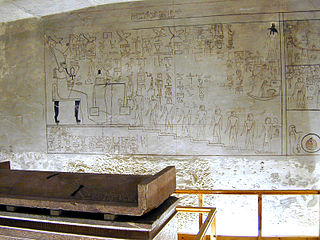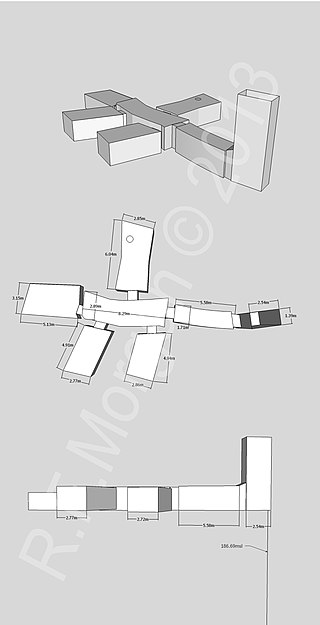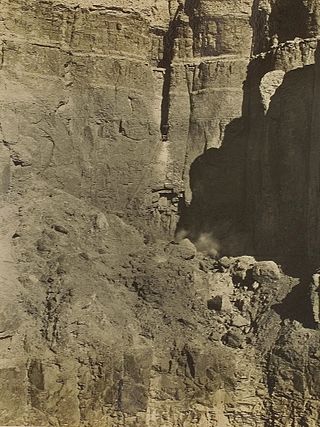
The tomb of Tutankhamun, also known by its tomb number, KV62, is the burial place of Tutankhamun, a pharaoh of the Eighteenth Dynasty of ancient Egypt, in the Valley of the Kings. The tomb consists of four chambers and an entrance staircase and corridor. It is smaller and less extensively decorated than other Egyptian royal tombs of its time, and it probably originated as a tomb for a non-royal individual that was adapted for Tutankhamun's use after his premature death. Like other pharaohs, Tutankhamun was buried with a wide variety of funerary objects and personal possessions, such as coffins, furniture, clothing and jewelry, though in the unusually limited space these goods had to be densely packed. Robbers entered the tomb twice in the years immediately following the burial, but Tutankhamun's mummy and most of the burial goods remained intact. The tomb's low position, dug into the floor of the valley, allowed its entrance to be hidden by debris deposited by flooding and tomb construction. Thus, unlike other tombs in the valley, it was not stripped of its valuables during the Third Intermediate Period.

Thutmose I was the third pharaoh of the 18th Dynasty of Egypt. He received the throne after the death of the previous king, Amenhotep I. During his reign, he campaigned deep into the Levant and Nubia, pushing the borders of Egypt farther than ever before in each region. He also built many temples in Egypt, and a tomb for himself in the Valley of the Kings; he is the first king confirmed to have done this.

Tomb KV17, located in Egypt's Valley of the Kings and also known by the names "Belzoni's tomb", "the Tomb of Apis", and "the Tomb of Psammis, son of Nechois", is the tomb of Pharaoh Seti I of the Nineteenth Dynasty. It is one of the most decorated tombs in the valley, and is one of the largest and deepest tombs in the Valley of the Kings. It was uncovered by Italian archaeologist and explorer Giovanni Battista Belzoni on 16 October, 1817.

Tomb KV60 is an ancient Egyptian tomb in the Valley of the Kings, Egypt. It was discovered by Howard Carter in 1903, and re-excavated by Donald P. Ryan in 1989. It is one of the more perplexing tombs of the Theban Necropolis, due to the uncertainty over the identity of one female mummy found there (KV60A). She is identified by some, such as Egyptologist Elizabeth Thomas, to be that of the Eighteenth Dynasty pharaoh Hatshepsut; this identification is advocated for by Zahi Hawass.

Tomb WV23, also known as KV23, is located in the Western Valley of the Kings near modern-day Luxor, and was the final resting place of Pharaoh Ay of the Eighteenth Dynasty. The tomb was discovered by Giovanni Battista Belzoni in the winter of 1816. Its structure is similar to that of the tomb of Akhenaten, with a straight descending corridor, leading to a "well chamber" that has no shaft. This leads to the burial chamber, which now contains the reconstructed sarcophagus, which had been smashed in antiquity. The tomb had also been anciently desecrated, with many instances of Ay's image or name erased from the wall paintings. Its decoration is similar in content and colour to that of Tutankhamun (KV62), with a few differences. On the eastern wall there is a depiction of a fishing and fowling scene, which is not shown elsewhere in other royal tombs, normally appearing in burials of nobility.

Tomb WV22, also known as KV22, was the burial place of the Eighteenth Dynasty pharaoh Amenhotep III. Located in the Western arm of the Valley of the Kings, the tomb is unique in that it has two subsidiary burial chambers for the pharaoh's wives Tiye and Sitamen. It was officially discovered by Prosper Jollois and Édouard de Villiers du Terrage, engineers with Napoleon's expedition to Egypt in August 1799, but had probably been open for some time. The tomb was first excavated by Theodore M. Davis, the details of which are lost. The first documented clearance was carried out by Howard Carter in 1915. Since 1989, a Japanese team from Waseda University led by Sakuji Yoshimura and Jiro Kondo has excavated and conserved the tomb. The sarcophagus is missing from the tomb. The tomb's layout and decoration follow the tombs of the king's predecessors, Amenhotep II (KV35) and Thutmose IV (KV43); however, the decoration is much finer in quality. Several images of the pharaoh's head have been cut out and can be seen today in the Louvre.

Tomb KV42 is an ancient Egyptian tomb located in the Valley of the Kings in Egypt. It was constructed for Hatshepsut-Meryetre, the wife of Thutmose III, but she was not buried in the tomb. It may have been reused by Sennefer, a mayor of Thebes during the reign of Amenhotep II, and by several members of his family. The tomb has a cartouche-shaped burial chamber, like other early Eighteenth Dynasty tombs.

Tomb KV43 is the tomb of Pharaoh Thutmose IV in the Valley of the Kings in Luxor, Egypt. It has a dog-leg shape, typical of the layout of early 18th Dynasty tombs. KV43 was rediscovered in 1903 by Howard Carter, excavating on behalf of Theodore M. Davis.

Tomb KV35 is the tomb of Pharaoh Amenhotep II located in the Valley of the Kings in Luxor, Egypt. Later, it was used as a cache for other royal mummies. It was discovered by Victor Loret in March 1898.

The tomb of Yuya and Thuya, also known by its tomb number KV46, is the burial place of the ancient Egyptian noble Yuya and his wife Thuya, the parents of Queen Tiye the chief wife of Pharaoh Amenhotep III. Located in the Valley of the Kings, it was discovered in February 1905 by the Egyptologist James E. Quibell, excavating under the sponsorship of American millionaire Theodore M. Davis. The tomb was robbed in antiquity but preserved a great deal of its original contents including chests, beds, chairs, a chariot, and numerous storage jars. Additionally, the riffled but undamaged mummies of Yuya and Thuya were found within their disturbed coffin sets. Prior to the discovery of the tomb of Tutankhamun, this was considered to be one of the greatest discoveries in Egyptology.

Tomb KV19, located in a side branch of Egypt's Valley of the Kings, was intended as the burial place of Prince Ramesses Sethherkhepshef, better known as Pharaoh Ramesses VIII, but was later used for the burial of Prince Mentuherkhepshef instead, the son of Ramesses IX, who predeceased his father. Though incomplete and used "as is," the decoration is considered to be of the highest quality.

KV4 is a tomb in the Valley of the Kings (Egypt). The tomb was initiated for the burial of Ramesses XI but it is likely that its construction was abandoned and it was not used for Ramesses's interment. It also seems likely that Pinedjem I intended to usurp this tomb for his own burial, but that he too abandoned the plan. KV4 is notable for being the last royal tomb that was quarried in the Valley and because it has been interpreted as being a workshop used during the official dismantling of the royal necropolis in the early Third Intermediate Period.

Tomb KV47, located in the Valley of the Kings in Egypt, was used for the burial of Pharaoh Siptah of the Nineteenth Dynasty. It was discovered on December 18, 1905 by Edward R. Ayrton, excavating on behalf of Theodore M. Davis; Siptah's mummy had been found earlier, cached in KV35. It was the last of the Nineteenth and Twentieth Dynasty kings tombs to be uncovered in the Valley. Ayrton stopped his excavation in 1907 due to safety fears, and Harry Burton returned in 1912 to dig further. The cutting of a side passage was halted after the workmen cut into Side Chamber Ja of the tomb of Tia'a (KV32). The tomb was unfinished at the time of its use.

Tomb KV57 is the royal tomb of Horemheb, the last pharaoh of the Eighteenth Dynasty and is located in the Valley of the Kings, Egypt.

Tomb KV30 is an ancient Egyptian tomb located in the Valley of the Kings in Egypt. It likely dates to the mid-Eighteenth Dynasty and was used for the burial of an unknown individual. It may have been discovered by Giovanni Belzoni in 1817, working on a commission from the Second Earl Belmore. It was excavated in 2009-2010 by the University of Basel's Kings' Valley Project.

KV31 is an ancient Egyptian tomb located in the Valley of the Kings, near Luxor, Egypt. Only the top of the shaft was known prior to excavation by the University of Basel Kings' Valley Project in 2010, and no earlier excavations are known, although it is suggested that the stone sarcophagus excavated by Giovanni Battista Belzoni in 1817 may have originated from this tomb. The tomb was found to be filled with mixed debris of pottery sherds and linen fragments, as well as the remains of five mummified elite individuals dating to the Eighteenth Dynasty.

The Valley of the Kings, also known as the Valley of the Gates of the Kings, is an area in Egypt where, for a period of nearly 500 years from the Eighteenth Dynasty to the Twentieth Dynasty, rock-cut tombs were excavated for pharaohs and powerful nobles under the New Kingdom of ancient Egypt.

KV64 is the tomb of an unknown Eighteenth Dynasty individual in the Valley of the Kings, near Luxor, Egypt that was re-used in the Twenty-second Dynasty for the burial of the priestess Nehmes Bastet, who held the office of "chantress" at the temple of Karnak. The tomb is located on the pathway to KV34 in the main Valley of the Kings. KV64 was discovered in 2011 and excavated in 2012 by Susanne Bickel and Elina Paulin-Grothe of the University of Basel.
The majority of the 65 numbered tombs in the Valley of the Kings can be considered minor tombs, either because at present they have yielded little information or because the results of their investigation was only poorly recorded by their explorers, while some have received very little attention or were only cursorily noted. Most of these tombs are small, often only consisting of a single burial chamber accessed by means of a shaft or a staircase with a corridor or a series of corridors leading to the chamber, but some are larger, multiple chambered tombs. These minor tombs served various purposes, some were intended for burials of lesser royalty or for private burials, some contained animal burials and others apparently never received a primary burial. In many cases these tombs also served secondary functions and later intrusive material has been found related to these secondary activities. While some of these tombs have been open since antiquity, the majority were discovered in the 19th and early 20th centuries during the height of exploration in the valley.

The cliff tomb of Hatshepsut, also referred to as tomb Wadi A-1, is the tomb quarried for her as Great Royal Wife of Thutmose II. It is located in Wady Sikkat Taqet Zaid, to the west of the Valley of the Kings near Luxor, Egypt. The tomb is cut into a slot in the vertical cliff face 70 metres (230 ft) above the valley floor. It is unfinished, with the cutting of the burial chamber never being completed. Although never used for a burial, it did contain a sarcophagus inscribed for Hatshepsut as Great Royal Wife. Originally found by local diggers, the tomb was later excavated by Howard Carter on behalf of the Earl of Carnarvon in 1916.

























